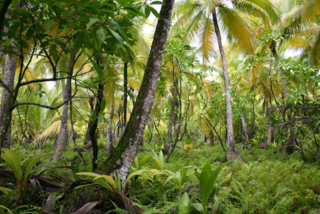
Aquatic plants are plants that have adapted to living in aquatic environments. They are also referred to as hydrophytes or macrophytes. A macrophyte is an aquatic plant that grows in or near water and is either emergent, submergent, or floating, and includes helophytes. In lakes and rivers macrophytes provide cover for fish and substrate for aquatic invertebrates, produce oxygen, and act as food for some fish and wildlife.

The ferruginous duck, also ferruginous pochard, common white-eye or white-eyed pochard is a medium-sized diving duck from Eurasia. The scientific name is derived from Greek aithuia an unidentified seabird mentioned by authors including Hesychius and Aristotle, and nyrok, the Russian name for a duck.

British Plant Communities is a five-volume work, edited by John S. Rodwell and published by Cambridge University Press, which describes the plant communities which comprise the British National Vegetation Classification.
This article gives an overview of the aquatic communities in the British National Vegetation Classification system.

A hydrosere is a plant succession which occurs in an area of fresh water such as in oxbow lakes and kettle lakes. In time, an area of open freshwater will naturally dry out, ultimately becoming woodland. During this change, a range of different landtypes such as swamp and marsh will succeed each other.
British NVC community SM1 is one of the salt-marsh communities in the British National Vegetation Classification system.
British NVC community MG13 is one of the mesotrophic grassland communities in the British National Vegetation Classification system. It is one of three types of mesotrophic grassland classified as grass-dominated inundation communities.
British NVC community MC1 is one of the maritime cliff communities in the British National Vegetation Classification system. It is one of five communities categorised as maritime cliff crevice and ledge communities.
British NVC community MC2 is one of the maritime cliff communities in the British National Vegetation Classification system. It is one of five communities categorised as maritime cliff crevice and ledge communities.
British NVC community SM24 is one of the salt-marsh communities in the British National Vegetation Classification system.

Callitriche stagnalis is a perennial aquatic vascular plant species. Also known as pond water-starwort, C. stagnalis, may thrive in a variety of aquatic and subaquatic habitats, specially those exhibiting slowly moving to non-moving water. Although C. stagnalis does not pose a threat to humans, its reproductive rate may pose a threat to native vegetation. Resulting dense vegetative mats frequently out-compete species in native communities.

Ranunculus fluitans is a species of buttercup. It is a perennial water plant, that when in favourable conditions it can grow up to 6 m (20 ft) height.

Browsing is a type of herbivory in which a herbivore feeds on leaves, soft shoots, or fruits of high-growing, generally woody plants such as shrubs. This is contrasted with grazing, usually associated with animals feeding on grass or other low vegetation. Alternatively, grazers are animals eating mainly grass, and browsers are animals eating mainly non-grasses, which include both woody and herbaceous dicots. In either case, an example of this dichotomy are goats and sheep ; these two closely related ruminants utilize dissimilar food sources.

Ecological dominance is the degree to which a taxon is more numerous than its competitors in an ecological community, or makes up more of the biomass. Most ecological communities are defined by their dominant species.
An intertidal wetland is an area along a shoreline that is exposed to air at low tide and submerged at high tide. This type of wetland is defined by an intertidal zone and includes its own intertidal ecosystems.

Plant ecology is a subdiscipline of ecology which studies the distribution and abundance of plants, the effects of environmental factors upon the abundance of plants, and the interactions among and between plants and other organisms. Examples of these are the distribution of temperate deciduous forests in North America, the effects of drought or flooding upon plant survival, and competition among desert plants for water, or effects of herds of grazing animals upon the composition of grasslands.

Potamogeton coloratus, the fen pondweed, is an aquatic plant in the genus Potamogeton. It is found in shallow peaty calcareous lakes, ponds and ditches, commonly associated with lowland fens.

The Floridian highlands freshwater marsh is a wetland community found on the Florida peninsula. These are upland marshes occurring in shallow peat-filled valleys, the basins of dried lakes, and the borders of existing lakes. The vegetation mosaic includes a range of mostly herbaceous plant communities, varying based on water depth. Deep water supports various submerged and floating plants. Approximately meter-deep supports emergent herbaceous perennials, typically in dense, monospecific stands; species include bulrush, pickerelweed, American lotus. Shallow areas only submerged during wet season support more graminoid vegetation, including maidencane and southern cutgrass. Subsurface subsidence and changing drainage patterns make these habitats shift and change over time. Soils can be mucky, loamy, or sandy, but they are generally above permeable subsoils that create standing water much of the year. These marshes may also be called meadows or prairies.












